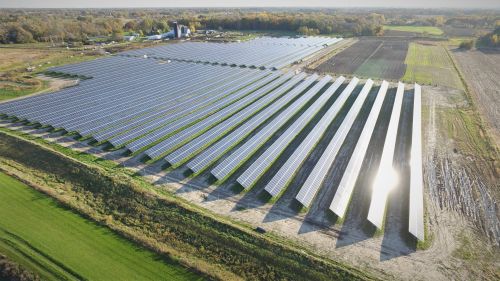Climate Control

Survey data shows that while Americans favor a range of policies to reduce energy dependence, economic growth takes priority.
Sandwiched between the George Zimmerman trial and Supreme Court announcements, President Obama announced his new energy strategy to combat climate change yesterday at Georgetown University. The speech outlined specific policy changes to address the United States global climate pledge to cut the nation’s carbon output to 17 percent below 2005 levels by the year 2020. Unlike other issues such as immigration reform or the healthcare bill, these policy changes can be executed through executive orders, therefore sidestepping congressional approval. These initiatives include limiting greenhouse gas emissions from power plants, increasing appliance efficiency standards, focusing on renewable energy development on public lands, and strengthening coastal communities to help cope with severe weather and flooding.
While this action may defuse some of the domestic and international pressure for American action on climate issues, it may also aggravate the worries of other Americans who are focused on a different kind of green. Several polls suggest that the increased costs related to stricter emission regulations and investment in renewable energy could elicit concern over perceived trade-offs between economic growth and the environment.
US Public Favors a Range of Policies to Reduce Energy Dependence in Principle
Obama’s speech reviewed the advances his administration has made in doubling wind and solar energy production and in mandating improvements in automobile fuel efficiency. According to the 2012 Chicago Council Survey, highlighting these items has resonance because Americans place greater urgency on the issue of energy independence (77% say it is a very important goal) than on limiting climate change (only 33%). A Pew survey released June 24th found that Americans are among the least concerned globally about climate change, with only four in ten saying it poses a major threat to the US.
As discussed in previous posts, "It's Not Easy Being Green", "What the Frack?", and "Splitting Atoms", Americans tend to choose expansion of new sources of energy over fossil fuel production, if given the choice. A February 2013 Pew/USA Today survey found continued preference for “developing alternative sources, such as wind, solar and hydrogen technology” (54%) over expanding exploration and production of oil, coal and natural gas (34%). A Gallup 2012 survey (without any downsides spelled out in the questions) reported majorities in favor of “setting higher emissions and pollution standards for business and industry (70%), spending government money on developing solar and wind power (69%), and the development of alternative sources of automobile fuel (66%), imposing mandatory controls on carbon dioxide emissions and other greenhouse gases (65%), opening up land owned by the federal government for oil exploration (65%), and stronger enforcement of federal environmental regulations” (62%). Americans are also willing to make tradeoffs when it comes to fuel efficiency standards for cars: the 2012 Chicago Council Survey showed that 65 percent of Americans favor higher fuel efficiency standards for automakers, even if it leads to an increase in car prices.
Economic Growth Takes Priority over Environment
"Remind folks there’s no contradiction between a sound environment and strong economic growth."
While supporting these broad goals to reduce our carbon footprint, slightly more Americans still place priority on economic growth over environmental protection. An April 2013 Gallup survey reported that 48 percent of Americans supported prioritizing economic growth over environmental protection, while 43 percent said that protecting the environment was the greater priority. A plurality also said that the government is doing too little in terms of protecting the environment (47%, with 16% too much and 35% about right). That percentage, while stable over the last several years, is a decline from the mid-2000s when an outright majority believed the government was doing too little to protect the environment.
Further analysis conducted by Gallup reveals a correlation between American support for environmental protection (versus environmental protection) and the annualized rate of change in the nation’s Gross Domestic Product (GDP). Before 2008, Americans typically demonstrated greater support for environmental protection. But by 2009, Americans gave greater priority to economic growth. While GDP growth has recently made a comeback, net support for environmental protection is still negative but less than it has been in recent years. A similar correlation was found in a trade-off question of economic protection versus energy production.
Many Americans Unaware of Consensus on Climate Change among Scientists
Besides economic pressures, another factor that limits American public urgency around climate change is that many Americans are not aware of the scientific consensus that climate change is real. While several targeted surveys among the scientific community and comprehensive literature reviews, have concluded that an overwhelming majority of scientists link climate change to human behavior, the American public is more divided. The 2012 Chicago Council Survey found that only four in ten Americans (38%) believe most scientists think climate change “is an urgent problem and enough is known to take action." The same proportion believes that scientists are "pretty evenly divided" on whether it is an urgent problem (42%) and an additional 19 percent think “is not an urgent problem and not enough is known yet to take action."
Partisan Divide on Climate Issues
Looking at the data by party identification, it is fairly clear why Obama decided to sidestep Congress on these announcements: attitudes toward climate change vary sharply across partisan groups. Republicans are far more concerned about economic growth than the environment (68% to 27%, respectively) while Democrats and independents stand quite the opposite (with 55% prioritizing the environment and only 35% focusing on the economy). Such partisan stances are also apparent in the February 2013 Pew/USA Today survey regarding the country’s energy priorities and emission standards. Here, 54 percent of Republicans preferred to support and expand upon the production of fossil fuels instead of alternative energy sources and were divided in their support of stricter emission limits on power plants. Meanwhile, Democrats and independents were far more supportive of developing alternative energy sources (64% Democrats, 59% Independents, 33% Republicans) and enforcing stricter emission limits (72% Democrats, 64% Independents, 42% Republicans).
Age Differences
It’s no accident that Georgetown University was chosen as the platform for this speech: younger Americans are more supportive of policies to limit climate change than older Americans. According to Pew results, Americans aged 18-29 are more concerned with environmental protection than economic growth (49%) than their 65+ counterparts (37%). They are also more likely to support the development of alternative energy sources (71%) and favor stricter emission limits (70%).
At the end of the day, Americans seem to aspire toward becoming better environmental stewards, but environmental priorities will remain a luxury for many during times of economic difficulty. But with the economy on the mend and with future generational replacement, Americans may increasingly embrace efforts to reduce global warming and mediate its costs.

